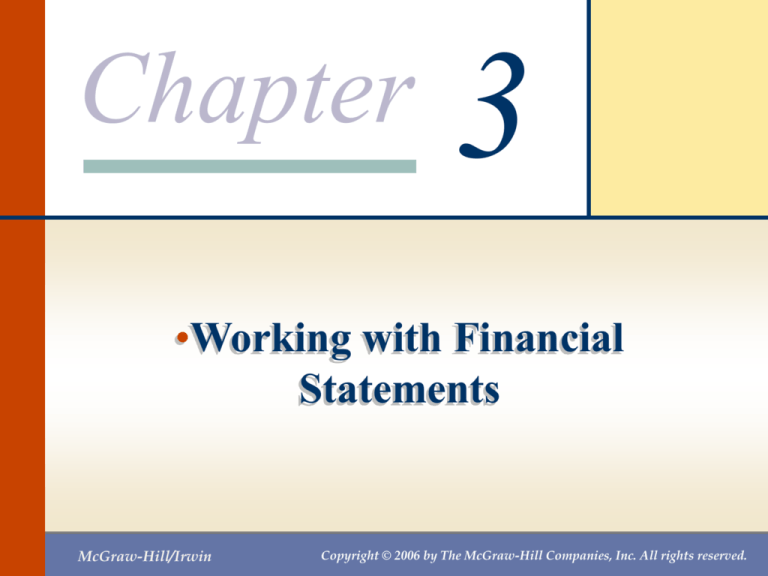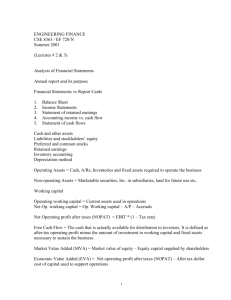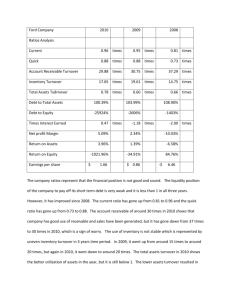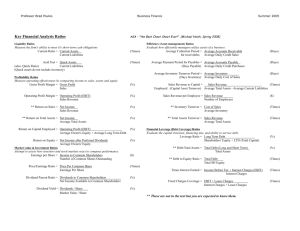
Chapter
3
•Working with Financial
Statements
McGraw-Hill/Irwin
Copyright © 2006 by The McGraw-Hill Companies, Inc. All rights reserved.
Chapter 3 – Index of Sample
Problems
•
•
•
•
•
•
•
•
Slide # 02 - 06
Slide # 07 - 08
Slide # 09 - 12
Slide # 13 - 18
Slide # 19 - 26
Slide # 27 - 33
Slide # 34 - 46
Slide # 47 - 48
Sources and uses of cash
Cash flow categories
Common-size statements
Liquidity ratios
Long-term solvency ratios
Asset utilization ratios
Profitability ratios, including DuPont
Market value ratios
2: Sources and uses of cash
Complete the table by indicating which accounts are a source
of cash and which are a use of cash. The next slide provides the
answers.
2005
2004
$ 18,900
$ 17,300
Accounts receivable
12,350
13,480
Inventory
76,200
75,400
425,000
452,000
26,800
28,500
Long-term debt
195,600
230,900
Common stock
220,000
210,000
90,050
88,780
Cash
Net fixed assets
Accounts payable
Retained earnings
Source/Use
U
3: Sources and uses of cash
The asset accounts are shown in light yellow. The liability and
equity accounts are in light blue.
Source/Use
2005
2004
$ 18,900
$ 17,300
U
Accounts receivable
12,350
13,480
S
Inventory
76,200
75,400
U
425,000
452,000
S
26,800
28,500
U
Long-term debt
195,600
230,900
U
Common stock
220,000
210,000
S
90,050
88,780
S
Cash
Net fixed assets
Accounts payable
Retained earnings
4: Sources and uses of cash
Balance Sheet
Asset
Cash
Increase
Decrease
Use
Source
Liabilities
and
Equity
Increase
Decrease
Cash
Source
Use
5: Sources and uses of cash
What is the amount of each source and use of cash?
Source/Use
2005
2004
$ 12,350
$ 13,480
S
Net fixed assets
425,000
452,000
S
Common stock
220,000
210,000
S
90,050
88,780
S
Accounts receivable
Retained earnings
Cash
$ 18,900
$ 17,300
U
Inventory
76,200
75,400
U
Accounts payable
26,800
28,500
U
195,600
230,900
U
Long-term debt
Amount of
source or use
$ 1,130
Total:
$39,400
Total:
$39,400
The asset accounts are shown in yellow. The liability and equity accounts are in blue.
6: Sources and uses of cash
The sources of cash must equal the uses of cash.
Source/Use
Amount of
source/use
2005
2004
$ 12,350
$ 13,480
S
1,130
Net fixed assets
425,000
452,000
S
27,000
Common stock
220,000
210,000
S
10,000
90,050
88,780
S
1,270
Accounts receivable
Retained earnings
Total:
Cash
$39,400
$ 18,900
$ 17,300
U
$ 1,600
Inventory
76,200
75,400
U
800
Accounts payable
26,800
28,500
U
1,700
195,600
230,900
U
35,300
Long-term debt
Total:
$39,400
7: Cash flow categories
For each of the following accounts, identify whether they are an
operating activity (O), an investment activity (I), or a financing
activity (F).
Account
Accounts payable
O, I, or F
O
Account
Cash
Accounts
receivable
Dividends paid
Long-term debt
Retained earnings
Net income
Interest paid
Inventory
Paid in surplus
Common stock
Sales
O, I, or F
8: Cash flow categories
Financing = Long-term debt, equity, interest paid and dividends
Investing = Long-term assets
Operating = Current assets, current liabilities and income statement accounts, excluding
interest paid
Account
O, I, or F
Account
O, I, or F
Accounts payable
O
Cash
O
Accounts
receivable
O
Dividends paid
F
Long-term debt
F
Retained earnings
F
Net income
O
Interest paid
F
Inventory
O
Paid in surplus
F
Common stock
F
Fixed assets
I
9: Common-size statements
Complete the table by inserting the common-size ratios.
Round all numbers to the nearest 1/10 of a percent.
Assets
Cash
Liabilities and equity
$ 1,200
4.9% Accounts
payable
$1,700
Accounts receivable
2,600
Long-term debt
9,800
Inventory
4,900
Common stock
10,000
Net fixed assets
Total assets
$1,200
4.9%
$24,300
15,600
Retained
earnings
$24,300 100.0% Total liabilities
and equity
2,800
$24,300
10: Common-size statements
Total assets is set equal to 100%. All other accounts are
expressed as a percentage of total assets.
Assets
Cash
Liabilities and equity
$ 1,200
4.9% Accounts
payable
$1,700
7.0%
Accounts
receivable
2,600
10.7% Long-term debt
9,800 40.3%
Inventory
4,900
20.2% Common stock
10,000 41.2%
Net fixed assets
Total assets
15,600
$24,300
64.2% Retained
earnings
100.0% Total liabilities
and equity
2,800
11.5%
$24,300
100.0
%
11: Common-size statements
Complete the table by inserting the common-size ratios.
Income Statement
Sales
$124,500
Costs of goods sold
87,500
Other costs
21,800
Depreciation
8,400
Interest
2,100
Taxes
Net income
750
$ 3,950
100%
12: Common-size statements
Sales is expressed as 100%. All other accounts are expressed
as a percentage of sales.
Income Statement
Sales
$124,500
100.0%
Costs of goods sold
87,500
70.3%
Other costs
21, 800
17.5%
Depreciation
8,400
6.7%
Interest
2,100
1.7%
750
0.6%
$ 3,950
3.2%
Taxes
Net income
Ratios
Short-term solvency, liquidity ratios
Long-term solvency, financial leverage
Asset management, turnover ratios
Profitability ratios
Market value ratios
13: Liquidity ratios
Use this information to calculate the ratios below.
Cash
$ 900
Accounts receivable
1,200
Inventory
2,100
Accounts payable
1,600
Average daily operating costs
70
Total assets
8,600
Current ratio = __________ Cash ratio
= __________
Quick ratio
= __________ Interval measure = __________
Net working capital to total assets = __________
14: Liquidity ratios
Current assets
Current liabilitie s
$4,200
$1,600
2.625
Current ratio
Cash
Accounts receivable
1,200
Inventory
2,100
Current assets
$ 900
Accounts payable
Current liabilities
1,600
$1,600
$4,200
Current assets - Inventory
Current liabilitie s
$4,200 $2,100
$1,600
1.3125
Quick ratio
Cash
Current liabilitie s
$900
$1,600
0.5625
Cash ratio
Answers continued on next slide.
15: Liquidity ratios
Cash
Accounts receivable
Inventory
Accounts payable
Average daily operating costs
Total assets
$ 900
$1,200
$2,100
$1,600
$ 70
$8,600
Current assets
Average daily operating costs
$4,200
70
60 days
Interval measure
Net workin g capital
Total assets
Current assets - current liabilitie s
Total assets
$4,200 $1,600
$8,600
.3023 (rounded )
Net workin g capital to total assets
30.23%
16: Liquidity ratios
Assume you start with this situation:
Cash
$100
Accounts receivable
100
Inventory
100
Total current assets
Accounts payable
$150
Total current liabilities
$300
$150
Current ratio
Current assets
Current liabilitie s
Current ratio
$300
2.0
$150
Now assume you pay $50 on your
accounts payable. You now have this
situation.
Cash
$ 50
Accounts receivable
100
Inventory
100
Total current assets
Accounts payable
$100
Total current liabilities
$250
$100
$250
Current ratio
2.5
$100
17: Liquidity ratios
Indicate for each action whether the current ratio, the quick
ratio and the cash ratio will increase (I), decrease (D) or not
change (NC). Assume net working capital is positive.
1. Short-term debt is paid
2. Long-term debt is paid
3. Inventory is sold on credit at a profit
4. Inventory is sold for cash at cost
5. A customer pays their bill
6. Inventory is purchased on accounts
payable
7. Inventory is purchased for cash
8. Cash is received from long-term loan
Current
______
______
______
______
______
Quick
______
______
______
______
______
Cash
_____
_____
_____
_____
_____
______
______
_____
______
______
_____
18: Liquidity ratios
Current
1. Short-term debt is paid
I
2. Long-term debt is paid
D
3. Inventory is sold on credit at a profit
I
4. Inventory is sold for cash at cost
NC
5. A customer pays their bill
NC
6. Inventory is purchased on accounts
payable
D
7. Inventory is purchased for cash
NC
8. Cash is received from long-term loan I
Quick
I
D
I
I
NC
Cash
I
D
NC
I
I
D
D
I
D
D
I
19: Long-term solvency ratios
Total assets
Long-term debt
Total debt
Total equity
EBIT (Earnings Before Interest and Taxes)
Interest
Depreciation
20: Long-term solvency ratios
Your firm has total assets of $146,000 and a total debt ratio of 40%.
What is the firm’s debt-equity ratio?
21: Long-term solvency ratios
Your firm has total assets
of $146,000 and a total debt
ratio of 40%. What is the
firm’s debt-equity ratio?
Step 1: Find total debt
Step 2: Find total equity
Step 3: Find debt-equity
ratio
Total assets - Total equity
Total assets
Total debt
Total assets
Total debt
.40
$146,000
Total debt $58,400
Total debt ratio
Total equity Total assets - total debt
$146,000 - $58,400
$87,600
Total debt
Total equity
$58,400
$87,600
.67 (rounded)
Debt - equity ratio
22: Long-term solvency ratios
Your firm has long-term debt of $63,000. The long-term debt
ratio is .40 and the equity multiplier is 1.8. What is the amount
of total assets?
Try this. If you get stuck, proceed to the next slide for a hint.
23: Long-term solvency ratios
Your firm has long-term debt of $63,000. The long-term debt
ratio is .40 and the equity multiplier is 1.8. What is the amount
of total assets?
Hint: By using the equity multiplier you can determine the
amount of total assets. But, you will need to know the amount
of total equity. Total equity can be found by using the longterm debt ratio.
24: Long-term solvency ratios
Your firm has long-term debt of $63,000. The long-term debt ratio
is .40 and the equity multiplier is 1.8. What is the amount of total
assets?
Step 1: Find total equity
Long - term debt
Long - term debt Total equity
$63,000
.40
$63,000 Total equity
Long - term debt ratio
$25,200 ..40 Total equity $63,000
.40 Total Equity $37,800
Total equity $94,500
Step 2: Find total assets
Total assets
Total equity
Total assets
1.8
$94,500
Total assets $170,100
Equity multiplier
25: Long-term solvency ratios
Your firm has earnings before interest and taxes of $27,931. The
times interest earned ratio is 5.3 and the cash coverage ratio is 8.6.
What is the amount of the interest paid expense?
What is the amount of the depreciation expense?
26: Long-term solvency ratios
Your firm has earnings before interest and taxes of $27,931.
The times interest earned ratio is 5.3 and the cash coverage
ratio is 8.6.
EBIT
Interest
$27,931
5.3
Interest
5.3 Interest $27,931
Times interest earned ratio
Step 1: Find the interest expense using
the times interest earned ratio
Interest $5,270
EBIT depreciati on
Interest
$27,931 Depreciati on
8.6
$5,270
$45,322 $27,931 Depreciati on
Cash coverage ratio
Step 2: Find the depreciation expense
using the cash coverage ratio
Depreciati on $17,391
27: Asset utilization ratios
Sales and accounts receivables are valued at the retail selling
price. Cost of goods sold, inventory and accounts payable are
valued at the wholesale purchase price.
When computing turnover rates, you match retail prices with
retail prices. You match wholesale prices with wholesale prices
as seen in the formulas.
Retail Prices
Wholesale Prices
Inventory turnover
Receivable s turnover
Sales
Accounts receivable
Cost of goods sold
Inventory
Accounts payable turnover
Cost of goods sold
Accounts payable
28: Asset utilization ratios
Your firm has sales of $927,450, accounts receivables
of $34,350, inventory of $48,600 and costs of goods
sold of $648,810.
What is the inventory turnover rate?
How many days does it take to sell inventory?
What is the accounts receivable turnover rate?
How many days does it take to collect payment from
a customer?
Round your answers to two decimal places.
29: Asset utilization ratios
Your firm has sales of $927,450, accounts receivables of $34,350,
inventory of $48,600 and costs of goods sold of $648,810.
Cost of goods sold
Inventory
$648,810
$48,600
13.35
Inventory turnover
365 days
13.35
27.34 days
Days' sales in inventory
Sales
Accounts receivable
$927,450
$34,350
27.00
Receivable s turnover
365 days
27.00
13.52 days
Days sales in receivable s
30: Asset utilization ratios
Your firm has current liabilities of $21,800, total assets of $82,900
and sales of $149,200. The net working capital is $4,600.
What is the NWC turnover rate?
What is the fixed asset turnover rate?
Round the turnover rates to two decimal places.
31: Asset utilization ratios
Your firm has current liabilities of $21,800, total assets of
$82,900 and sales of $149,200. The net working capital is
$4,600.
Sales
NWC
$149,200
$4,600
32.43
NWC turnover
Sales
Total assets
$149,200
$82,900
1.80
Total asset turn over
32: Asset utilization ratios
Your firm has current liabilities of $21,800, total assets of $82,900
and sales of $149,200. The net working capital is $4,600.
What is the total asset turnover rate?
Round the turnover rate to two decimal places.
33: Asset utilization ratios
Your firm has current liabilities of $21,800, total assets of
$82,900 and sales of $149,200. The net working capital is
$4,600.
Net workin g capital Current assets - current liabilitie s
$4,600 Current assets - $21,800
Current assets $26,400
Net fixed assets Total assets - current assets
$82,900 - $26,400
$56,500
Sales
Net fixed assets
$149,200
$56,500
2.64
Fixed asset turn over
34: Profitability ratios
Your firm has net income of $123,000 on sales of $2.4 million. Total
assets are $2.46 million and total equity is $1.5 million.
What is the profit margin?
What is the return on assets?
What is the return on equity?
35: Profitability ratios
Your firm has net income of
$123,000 on sales of $2.4
million. Total assets are $2.46
million and total equity is $1.5
million.
Net income
Return on equity
Total equity
$123,000
$1,500,000
.082
8.2%
Net income
Sales
$123,000
$2,400,000
.05125
Profit margin
5.125%
Net income
Total assets
$123,000
$2,460,000
.05
Return on assets
5%
36: Profitability ratios
Your firm has net income of $368,400, total assets of $23.946
million and an equity multiplier of 1.6.
What is the return on equity?
37: Profitability ratios
Your firm has net income of
$368,400, total assets of $23.946
million and an equity multiplier of
1.6. What is the return on equity?
Step 1: Find total equity (TE)
Step 2: Find return on equity (ROE)
Total assets
Equity multiplier
Total equity
$23,946,000
1.6
Total equity
1.6 Total equity $23,946,000
Total equity $14,966,250
Net income
Return on equity
Total equity
$368,400
Return on equity
$14,966,250
Return on equity .024615385
2.46%
38: Profitability ratios
A firm has net income of $368,400,
total assets of $23.946 million and
an equity multiplier of 1.6. What is
the return on equity?
Step 1. Compute ROA
Step 2. Compute ROE
Net income
Total assets
$368,400
$23,946,000
.0154
ROA
ROE ROA EM
Net income
Net income Total assets
Total equity Total assets Total equity
ROE ROA EM
.015384615 1.6
.0246
2.46%
39: Profitability ratios
What is the DuPont formula?
What is each part of the DuPont formula called?
Why use the DuPont formula?
40: Profitability ratios
What is the DuPont formula?
What is each part of the DuPont formula called?
Why use the DuPont formula? (listen for this answer)
ROE Profit margin Total asset turnover Equity multiplier
ROE
Net income
Sales
Sales
Total assets
Total assets
Total equity
41: Profitability ratios
Your firm has sales of $324,000 and total assets of $216,000. The
debt-equity ratio is .5 and the profit margin is 5.4%.
What are the values of the three parts of the DuPont formula?
What is the ROE?
Try to solve this problem before proceeding. If you get stuck, the
next slide provides some hints.
42: Profitability ratios
Your firm has sales of $324,000 and total assets of $216,000. The
debt-equity ratio is .5 and the profit margin is 5.4%.
What are the values of the three parts of the DuPont formula?
What is the ROE?
Hint:
Step 1: Solve for total equity using the debt-equity ratio and this
formula: TA = TD + TE
43: Profitability ratios
Your firm has sales of $324,000 and total
assets of $216,000. The debt-equity ratio
is .5 and the profit margin is 5.4%. What
are the values of the three parts of the
DuPont formula? What is the ROE?
ROE PM TAT EM
Sales
PM
Total assets
Total debt
Total equity
Total debt
.5
Total equity
.5 Total equity Total debt
Debt - equity ratio
Total assets Total debt Total equity
$216,000 .5 Total equity Total equity
$216,000 1.5 Total equity
$144,000 Total equity
.054
$324, 000
$216, 000
.054 1.5 1.5
.1215
12.15%
Total assets
Total equity
$216, 000
$144, 000
44: Profitability ratios
Your firm has sales of $12,600, total assets of $8,100, and a debtequity ratio of .80. The return on equity is 14%.
What is the net income?
Try to solve this by yourself. If you can’t, then see the hint on the
next slide.
45: Profitability ratios
Your firm has sales of
$12,600, total assets of
$8,100, and a debt-equity
ratio of .80. The return on
equity is 14%.
What is the net income?
Here are some formula hints.
Net income
ROE
Total equity
TD TA - TE
TA - TE
Debt - equity ratio
TE
46: Profitability ratios
Your firm has sales of
$12,600, total assets of
$8,100, and a debt-equity
ratio of .80. The return on
equity is 14%.
What is the net income?
Total assets - total equity
Total equity
$8,100 Total equity
.8
Total equity
.8 Total equity $8,100 - Total equity
Debt - equity ratio
1.8 Total equity $8,100
Total equity $4,500
Net income
Total equity
Net income
.14
$4,500
$630 Net income
ROE
47: Market value ratios
A firm has net income of $638,000 and total equity of $3.828 million.
There are 200,000 shares of common stock outstanding. Each
share is currently selling for $76.56.
What is the P/E ratio?
What is the market-to-book ratio?
48: Market value ratios
A firm has net income of
$638,000 and total equity of
$3.828 million. There are
200,000 shares of common
stock outstanding. Each
share is currently selling for
$76.56.
Net income
Number of shares
$638,000
200,000
$3.19
EPS
Price per share
Earnings per share
$76.56
$3.19
24
P/E
Market val ue per share
Book value per share
Market val ue per share
Total equity
Number of shares
$76.56
$3,828,000
200,000
$76.56
$19.14
4
Market - to - book
Chapter
3
•End of Chapter 3
McGraw-Hill/Irwin
Copyright © 2006 by The McGraw-Hill Companies, Inc. All rights reserved.








